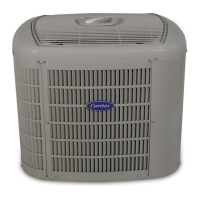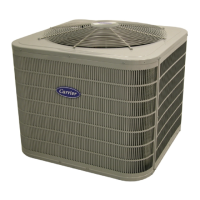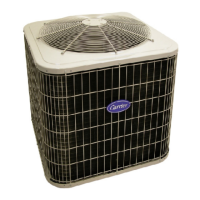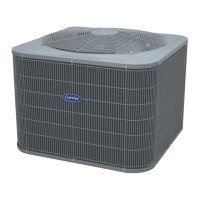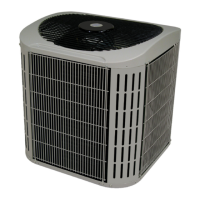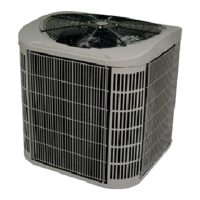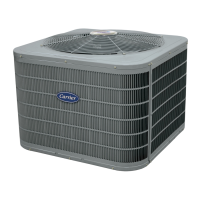9
Follow these steps to properly start up the
system:
1. After system is evacuated, fully open liquid and vapor
service valves.
2. Unit is shipped with valve stem(s) front seated (closed)
and caps installed. . Open fully by turning the stem
counter clockwise as far as it will go, and tighten lightly.
This opens the valve to refrigerant flow, and closes the
gage port. To leave gage port open, fully open the valve,
and then turn the stem clockwise a few turns. This will
allow pressure to be sensed without restricting refrigerant
flow.
Replace stem caps after system is opened to refrigerant
flow. Replace caps finger--tight and tighten with wrench
an additional 1/12 turn
NOTE: The gage port does not contain a Schrader core.
3. Close electrical disconnects to energize system.
4. Set room thermostat at desired temperature. Be sure set
point is below indoor ambient temperature.
5. Set room thermostat to COOL and fan control to ON or
AUTO mode, as desired. Operate unit for 15 minutes.
Check system refrigerant char ge.
STEP 12 —Check Charge
Unit
Charge
Factory charge and charging methods are shown on unit
information plate. Charge Puron refrigerant units with cylinder in
up righ t p ositio n an d a co m mercial--ty pe metering d ev ice in
manifold hose. Charge refrigerant into suction line.
NOTE: If subcooling charging conditions are not favorable,
charge must be weighed in accordance with unit rating plate, ±0.6
oz/ft. of 3/8--in. liquid line above or below 15 ft., respectively.
Favorable conditions fall within the ranges given on the charging
chart on the outdoor unit plate.
NOTE: In longline applications, see Application Guideline for
special charging requirements.
EXAMPLE:
To calculate additional charge required for a 25 ft. line set:
25 ft. -- 15 ft. = 10 ft. X 0.6 oz/ft. = 6 oz. of additional charge.
Cooling Only Procedur
e
This system requires charging by the subcooling method.
1. Operate unit a minimum of 10 minutes before checking
charge.
2. Measure liquid service valve pressure by attaching an
accurate gage to service port.
3. Measure liquid line temperature by attaching an accurate
thermistor type or electronic thermometer to liquid line
near outdoor coil.
4. Refer to unit rating plate for required subcooling
temperature.
5. Refer to Table 4. Find the point where required subcooling
temperature intersects measured liquid service valve
pressure.
6. To obtain required subcooling temperature at a specific
liquid line pressure, add refrigerant if liquid line
temperature is higher than indicated or reclaim refrigerant
if temperature is lower. Allow a tolerance of ±3_F.
Major
Components
Control Board
The AC control board controls the following functions:
S Compressor contactor operation
S Outdoor fan motor operation
S Compressor external protection
S Pressure switch monitoring
S Time Delays
Field Connections
When used with a standard thermostat, it is recommended to use
3 thermostat control wires to be connected to R, Y and C. When
using 3 wires, all diagnostic and time delay features are enabled
(See Fig. 15).
Wh en o nly 2 th ermo stat con trol w ires are av ailable, u n its
beginning with serial numbers 3006E and newer will function,
but some control features are lost. (See Fig. 16). With only 2
wires connected, the circuit board will be powered down
wh en ever th ere is n o call for co o ling , an d th e follo w in g w ill
result:
S Compressor time delay is reduced from 5 minutes to 10
seconds
S When the thermostat is not calling for cooling, the amber
status light will be off, and no diagnostics codes will be
available
S All system counters will be reset on each new call for
cooling
When using Infinity Communicating control, 4 wires are required
to be connected to the ABCD terminal (see Fig. 14)
Compressor Internal Relief
The compressor is protected by an internal pressure relief (IPR)
which relieves discharge gas into the compressor shell when
differential betw een suctio n an d disch arge pressu re exceed s
550--625 psi. The compressor is also protected by an internal
overload attached to motor windings.
GENERAL SEQUENCE OF OPERATION
STANDARD THERMOSTAT
Turn on power to indoor and outdoor units. Transformer is
energized.
On a call for cooling, thermostat makes circuits R--Y and R--G.
Circuit R-- Y energizes contactor, starting outdoor fan motor and
compressor circuit. R-- G energizes indoor unit blower relay,
starting indoor blower motor on high speed.
NOTE: To achieve the rated system performance, the indoor unit
or the thermostat must be equipped with a time delay relay
circuit.
When thermostat is satisfied, its contacts open, de--energizing
contactor and blower relay. Compressor and motors stop. If
indoor unit is equipped with a time-- delay relay circuit, the indoor
blower will run an additional 90 sec to increase system efficiency.
24APA

